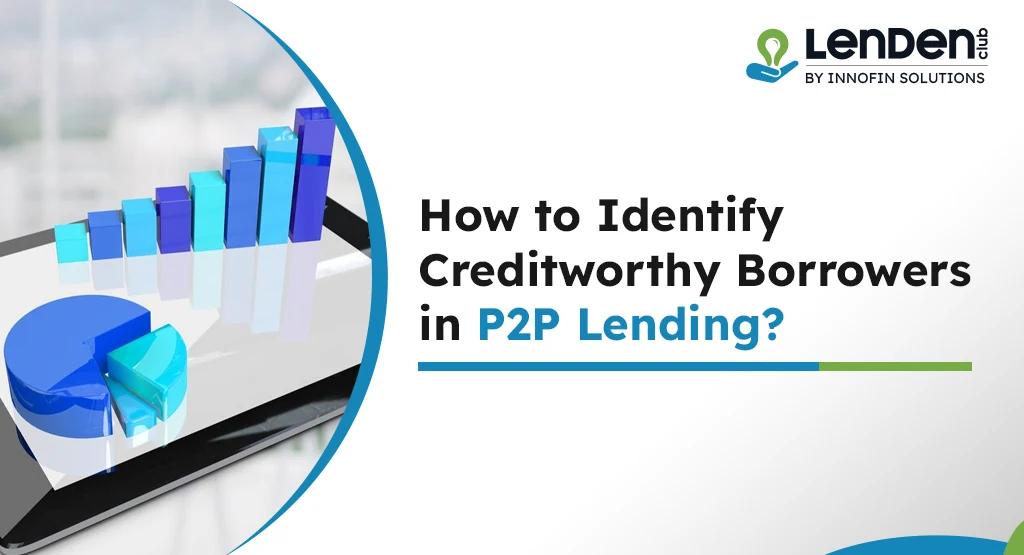How to Identify Creditworthy Borrowers in P2P Lending

P2P lending apps, such as LenDenClub, have made it easier than ever for lenders to connect with borrowers and make informed decisions. But the big question is how do you determine which borrowers are creditworthy?
The answer is so simple: it lies in the wealth of data available on these platforms. By analyzing key borrower details, you can minimize risks and maximize returns.
For your ease, we have created this blog, which will guide you through the process of evaluating borrowers using the information provided by apps like LenDenClub.
Key Borrower Details to Consider
On P2P lending platform like LenDenClub and similar platforms, you have access to several borrower details that can help you assess their creditworthiness. Let’s have a look.
1. Loan Amount and Tenure
Understanding the loan amount and tenure is crucial.
- Loan Amount: Does the borrower’s request seem reasonable based on their financial situation? Smaller loans are generally less risky, especially for first-time lenders.
- Loan Tenure: Shorter repayment tenures reduce the risk of default as the borrower is less exposed to long-term financial uncertainties.
For example, if a borrower requests a small loan with a short tenure, it indicates a manageable repayment plan, which may lower the risk.
2. Repayment Frequency
Repayment frequency reflects the borrower’s ability to repay regularly.
Borrowers who commit to monthly repayments demonstrate a structured financial habit.
3. Annualized Interest Rate
The annualized interest rate provides insights into the borrower’s risk category. Typically, higher interest rates are offered to higher-risk borrowers, while low-risk borrowers enjoy more favorable rates.
- Match the interest rate with the borrower’s risk category to ensure you are fairly compensated for your risk.
4. Personal Details: Age and Gender
Knowing a borrower’s age and gender can provide additional context about their financial stability.
- Age: Younger borrowers might be at an early stage of their career, while older borrowers may have more financial responsibilities or stability.
- Gender: While gender itself isn’t a direct indicator of risk, it helps form a complete borrower profile.
For instance, a borrower in their mid-30s with a steady job and strong credit history may be less risky than someone with no established track record.
5. Professional Details: Employment Type
Employment details are a key determinant of repayment ability.
- Self-Employed: Look for stable income from established businesses. Entrepreneurs with fluctuating incomes might carry higher risks.
- Salaried Employees: Borrowers with steady monthly salaries often demonstrate better repayment capacity.
Tip: Apps like LenDenClub clearly indicate whether a borrower is salaried or self-employed.
6. CRIF Score
The CRIF Score is a borrower’s credit score provided by the Centre for Research in International Finance.
This score reflects the borrower’s creditworthiness based on their credit history, repayment behaviour, and outstanding loans.
7. Risk Category
LenDenClub assigns borrowers to risk categories such as low, medium, or high based on their financial profile.
- Low-Risk Borrowers: These borrowers often have strong credit histories, stable incomes, and consistent repayment records.
- Medium-Risk Borrowers: May offer higher returns but come with moderate risk.
- High-Risk Borrowers: These borrowers may default but typically offer higher interest rates to compensate.
Match your risk appetite with the borrower’s category to make the right choice.
How to Use This Information to Identify Creditworthy Borrowers
Now that you understand the available data, here’s a step-by-step process to evaluate borrowers effectively.
Step 1: Start with the Risk Category
Begin by filtering borrowers based on their risk category. If you are a conservative lender, focus on low-risk borrowers.
Step 2: Analyze the CRIF Score
Look for borrowers with higher CRIF scores, as they demonstrate a strong repayment history.
Step 3: Assess Loan Details
Review the loan amount, tenure, and repayment frequency. Ensure they align with the borrower’s financial capacity and your risk tolerance.
Step 4: Cross-Check Personal and Professional Details
Verify the borrower’s age, gender, and employment type. Stable salaried borrowers or self-employed individuals with established businesses are generally safer bets.
Step 5: Diversify Your Portfolio
Even after thorough analysis, diversification is crucial. Spread your investments across borrowers from different risk categories to minimize potential losses.
Why LenDenClub Simplifies Borrower Assessment
LenDenClub provides a transparent of borrower profiles. The app’s user-friendly interface offers:
- Comprehensive borrower information at a glance.
- Tools to calculate potential returns and risks.
- Risk categorization for informed decision-making.
By leveraging these features, you can confidently identify creditworthy borrowers and build a secure, high-yield portfolio.
Final Thoughts
P2P lending offers tremendous potential for investors seeking higher returns, but success depends on identifying the right borrowers. Apps like LenDenClub provide all the data you need—loan details, repayment frequency, CRIF scores, and more—to make informed decisions.
By following a systematic approach and leveraging the tools at your disposal, you can reduce risks, optimize returns, and enjoy a rewarding P2P lending experience.